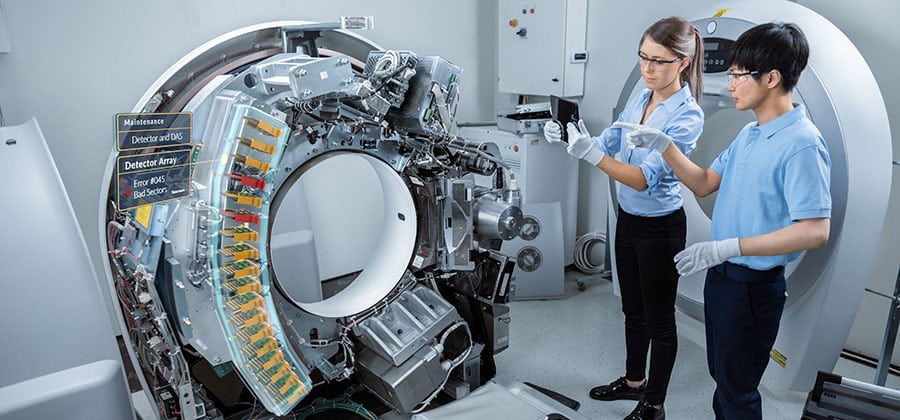
Augmented Reality and Staff Training
Traditional training methods for the industrial workforce are expensive and ineffective. Many leading companies are therefore turning to Augmented Reality to help them overcome the growing skills gap and remain competitive.
Many companies with onboarding programs interviewed have reported higher assimilation rates of new hires to corporate culture, a much higher ratio of learning time to productivity, and greater employee engagement.
AR offers extraordinary value for training and education activities with highly engaging visual learning experiences. A recent survey found that traditional training methods are inefficient and ineffective for frontline workers. Workers will forget 50% of information within one hour, 70% within 24 hours, and 90% within one hour in a week.
Added to this is that many companies will soon be burdened by the loss of knowledge of an elderly retirement workforce. Therefore, many manufacturing companies are rapidly implementing new and more modern strategies for training activities.
Benefits of AR Training
In the workplace, AR can enhance the learning and comprehension of both trainees and seasoned workers. Additionally, AR can boost employee engagement and safety awareness, alleviate training costs, and lower learning curves.
Engagement: There is truth in the concept that people learn by doing. AR provides the opportunity for hands-on learning in a structured, interactive way. With physical devices, trainees can practice job activities in real-time at their own pace and without pressure from customers, managers and performance expectations.
Safety: Some job situations are inherently dangerous, and training for them can be equally so. AR allows new employees to practice these tasks without the risk of injury or endangerment.
Training Costs: While AR training equipment’s initial costs can be high, the equipment is reusable, and most people will have hardware of their own in the form of a cell phone. AR headsets and apps can replace the need for costly seminars or classes.
Cognitive Barriers: Sometimes, job training can be challenging. There are high learning curves for many careers, even with an adequate education. This kind of hands-on learning allows trainees to understand how things are supposed to work and how to handle it when things go awry. They can take the time to understand the material comprehensively.
There are many more benefits of AR, so here is a non-extensive list:
- AR can motivate trainees to learn more about the job activity and company because it’s a more innovative and exciting experience.
- There is more potential for training opportunities, even for seasoned workers. Training can also be available on-demand.
- Using AR can encourage and help trainees retain information, knowledge, and skills.
- It can help create less dependency on personnel, who can then perform their primary tasks more frequently.
Credit picture:https://www.press.bmwgroup.com/
How to Use Augmented Reality in Training
According to an ISACA survey, Augmented Reality (AR) consumers across five different countries rated AR as one of the top three technologies for training and development.
Whether your organization needs to develop technical skills like maintenance and repair or upgrade its onboarding programs and change management initiatives, AR is a solution that captivates all generations of workers.
AR Image Targeting
Staff can scan real-world 2D images and overlay 2D video, text, and pictures or 3D objects on them. AR Image Targeting can aid employees on the job, add flavor to onboarding training, or enhance current ILT/eLearning courses.
AR Ground Plane Object Breakaway
Your staff can place a 3D model of any object onto a tabletop or floor surface. They can then rotate the object, break the thing apart to view internal components, get detailed information or even find step-by-step instructions on how to repair or install the object.
AR Scenario Training
Users can place a 3D model of any object onto a tabletop or floor surface. They can interact with the thing and interact with actors (or objects) simultaneously with branched learning.
Summarizing
- AR Augmented Reality accelerates learning curves.
- AR Augmented Reality prevents loss of consciousness.
Industrial companies risk losing valuable skills as older workers retire. AR can help capture their knowledge and turn it into a guide for less experienced workers.
- AR Augmented Reality is cheaper than traditional training.
Traditional training expenses include printed manuals and documentation, trips to off-site training facilities, and salaries for trainees.
- AR Augmented Reality significantly reduces these training costs.
The primary cost savings come from the fact that AR drives the fastest learning curves for trainees.
Convergence Consulting has the skills to help build tailor-made, Augmented Reality Projects that can meet your requirements. We understand how best-in-class technologies work and the know-how to implement them to give you a competitive advantage in your business.



Leave a Reply